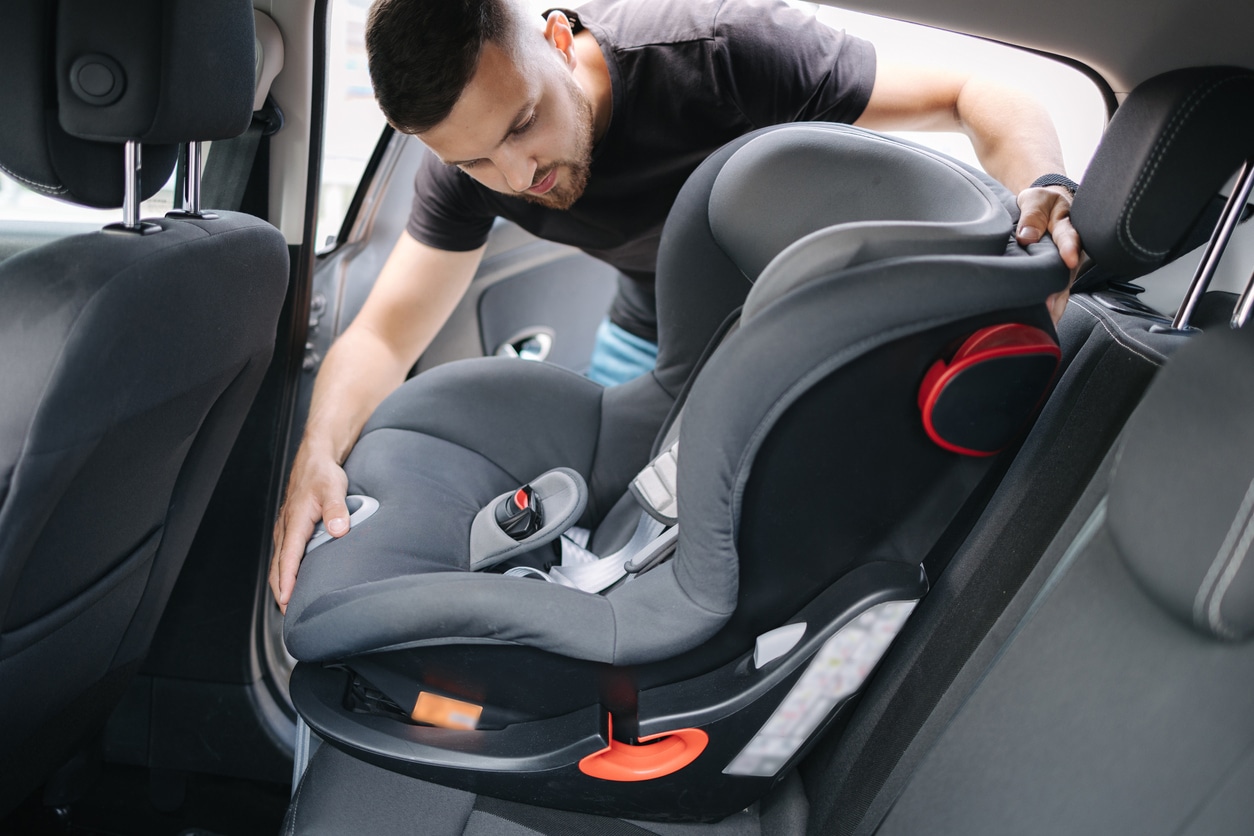Car accidents killed or injured over 150,000 children under 16 in the US in 2020 [1]. Such accidents can have a long-lasting impact on everyone involved. Yet, despite the increased focus on safety, many people still do not use an appropriate car seat or booster seat when driving with young children. What happens if an accident and the child is not secured correctly? Does this affect liability in an accident claim?
The answer is yes. Besides the fact that using the correct car seat is essential for a child’s safety in a vehicle, not doing so can affect any claims made by those involved in a car accident. It is, therefore, crucial for drivers to understand how a lack of car seats can affect their liability in the event of an accident claim.
Understanding Colorado Car Seat Laws
According to the Colorado Car Seat Laws [2], parents and caregivers are responsible for correctly restraining a child while riding in a car. A child restraint system is a seating system that meets federal motor vehicle standards, is permanently attached to the vehicle or to the vehicle’s safety belt system, and is designed to protect, hold, or restrain a child to prevent or minimize injury.
“Properly restraining” means that they need to follow the different requirements that the law sets depending on the age and size of the child. Parents and caregivers must install and fit the safety seat according to the manufacturer’s instructions and the vehicle’s manual. Car seat manufacturers will state the appropriate height/weight/age parameters for their seats, and you must follow these instructions.
Parents and caregivers who fail to do so can be pulled over and are subject to a fine—$100 for a first-time violation or $250 if a repeat violation as of 2023. They can also face additional charges if the law is not followed and a child is injured.
In summary, the law specifies that:
- Infants under 1 year old and under 20 lbs. must always ride in the back seat with no exemptions and for all types of vehicles.
- Toddlers older than one year old and heavier than 20 pounds can have their safety seat in the front passenger seat of a single-cab pickup truck. In such a case, you must place the seat as far from the airbag as possible and tightly secure it in the safety seat. Because of front seat airbags, having a child riding in the front seat is not recommended. If you need to do so, you should never place a rear-facing child restraint in front of an active airbag.
- Children up to 8 years old and under 57 inches in height must be in a safety seat—whether that is a booster seat or a five-point-harness car seat—and restrained in the appropriate child-restraint system.
- Children up to 15 years old riding in a motor vehicle should be properly secured with a child restraint system or a standard seat belt.
While the above is the minimum requirement set by Colorado law, it is strongly recommended to keep children in the back seat and a booster seat until they can use a standard seat belt without risk of injury and are about 4 feet 9 inches tall—which is the height of an average 12-year-old.
What Are the Injury Risks for Unrestrained or Incorrectly Restrained Children in Car Accidents
When children are not restrained or restrained incorrectly in a car during an accident, they are at a high risk of sustaining various injuries and even death. According to statistics from the Colorado Department of Transportation, 20 fatalities statewide in 2020 involved children under 15 who were occupants of passenger cars [3].
Children are smaller and lighter than adults, making them more likely to be thrown inside the vehicle during a crash. Because children’s muscles are not as developed as adults, they may not be able to brace themselves during an impact. In addition, their immature skeletal system is more vulnerable to fractures and other injuries.
Some common injuries can occur when a child rides a car unrestrained or improperly restrained.
Head and Neck Injuries
During a crash, unrestrained children risk hitting their heads on hard car surfaces, such as the dashboard or the window. This can result in traumatic brain injuries, skull fractures, and other serious head injuries.
Additionally, if they use a standard car seat belt that is inappropriate for their height and weight, the shoulder belt may cross over their neck or face and cause neck or head injuries.
Spinal Injuries
Unrestrained children are at risk of spinal injuries from the force of a crash. These injuries can include fractures, dislocations, and damage to the spinal cord.
Chest and Limb Injuries
Unrestrained children are at risk of chest injuries from hitting the steering wheel, dashboard, or other hard surfaces in the car. Chest injuries can include broken ribs, collapsed lungs, and other damages. Limb injuries may consist of broken bones and dislocated joints.
Abdominal Injuries
Children who are not adequately restrained can suffer abdominal injuries, such as damage to internal organs, from being thrown forward or sideways in the car during a crash.
In addition, the lap belt may ride up onto the abdomen instead of the hips if they use a standard seat belt. This can cause abdominal severe injuries in case of an accident.
Does Failing to Buckle a Child Affect Your Auto Accident Claim?
There are several ways that the failure to buckle a child can affect an auto accident claim.
Causing an Accident
When a child is not restrained, they can move around the vehicle and distract the driver, leading to the driver losing focus. The driver may then cause an accident and potentially cause injuries to someone, either to a child or another party. In this case, the driver can be found negligent and bear the liability for the accident and any personal injuries.
While it is sometimes difficult for an injury victim to prove that a driver was negligent, a driver is considered negligent per se if they violate Colorado State law. Negligent per se drivers must compensate injury victims for medical bills and expenses, property damage, lost wages and future lost earnings, and pain and suffering. A driver who causes an accident while distracted by an unrestrained child would be negligent per se for failing to use a child restraint system.
Comparative Negligence When Your Child Is Not Properly Restrained
Suppose your child was improperly restrained and injured due to an accident caused by a third party. In that case, the other driver’s insurance company or defense attorney may argue that your negligence in not restraining your child contributed to their injuries.
Comparative negligence is in use in Colorado. If multiple parties are at fault for an accident, each party’s fault will be assessed, and damages will be apportioned accordingly. Hence, if you were negligent and contributed to your child’s injuries, the compensation you can recover could be reduced. You may still be able to recover some damages from the other driver’s insurance company, but not to the full extent.
What If My Child Is in an Incorrect Car Seat for Their Age and Weight?
Since Colorado laws specify the type of safety seat required depending on the age and height of children, there may be legal consequences for the parent or caregiver if a child is injured in an accident because they were not adequately restrained in the appropriate type of car seat for their age, height, and weight.
Suppose the child’s injuries were caused by the fault of a third party, such as another driver who caused the accident. In that case, the other driver’s insurance company or defense attorney might argue that your failure to restrain the child properly contributed to their injuries. Within the comparative negligence framework, this may reduce your compensation.
You may be liable for the child’s injuries if you are at fault for a car accident and your child was not properly secured in an adequate safety car seat. In this case, obtaining compensation from your insurance company for your child’s injuries may be difficult, as Colorado follows a fault-based system: the party responsible for causing an accident is generally responsible for paying personal injury damages.
Whatever the case, if you have been involved in an accident in Colorado and your child was not properly restrained in a car seat adequate for their age and weight, you violate the law and may be subject to fines and other penalties.
What If My Child Was in the Seat, but the Car Seat Was Not Installed?
If your car seat shifts during a car accident because it was not adequately latched or installed in the car, there may be consequences for your claim, even if you are using the correct type of car seat for your child’s age and weight.
In this case, the cause of the injuries is the failure to properly install or secure the car seat, not the car seat itself. Depending on the specific circumstances of the accident, this may affect your attempts to claim compensation for your child’s injuries from the other driver’s insurance company or in a lawsuit because of comparative negligence.
Can a Lawyer Help Me with Accidents Involving Car Seat Issues?
If you have been involved in an accident in Colorado and your child was not restrained, or the child was restrained in the wrong type of car seat, or the car seat was not correctly attached to the vehicle, consult right away with a personal injury attorney who can advise you on your legal rights and options based on your specific circumstances.
A lawyer with robust expertise in personal injury and car accidents will help you present your case to achieve the highest compensation possible in the face of comparative negligence. We work on a contingency fee, so you only have to pay us after we successfully handle your case.
If you are considering employing a top-rated car accident attorney, call us at (303) 351-2567, or visit our offices to discuss your case in complete confidence. Our seasoned lawyers at Legal Help in Colorado will answer any questions you may have and help you gain a better understanding of your case and available options.
References
[1] https://www.forbes.com/advisor/legal/car-accident-statistics/
[2] https://www.codot.gov/safety/carseats/colorado-child-passenger-safety-law-1
[3] https://www.codot.gov/news/2021/september-2021/car-crashes-leading-cause-of-death-for-kids



